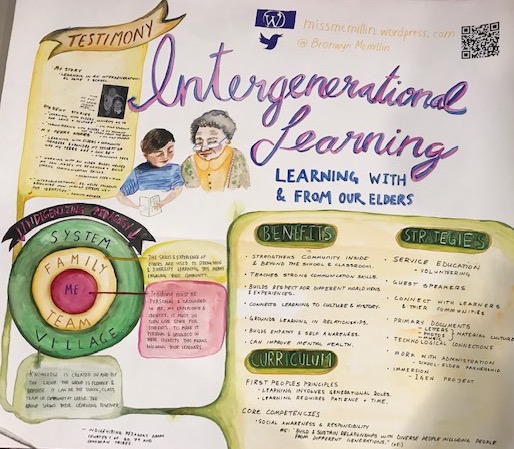EDCI 780 Inquiry
For my inquiry project as a pre- service teacher at Victoria High School I researched benefits and strategies for integrating inter-generational learning into high school classrooms and culture. Intergenerational learning is learning with and from our elders. My inquiry topic is inspired by programs such as Igen (Intergenerational Classroom) in Saskatoon which pairs grade 6 learners with elders in the community full time for a year. I want to strategize how learning with elders in schools might ground students in their community and ground them in relationships and culture.
I am driven to investigate intergenerational learning from my own experience. I lived with my grandparents as an adolescent and learned under their tutelage. I also went to a high school where Indigenous elders were often present in the classroom or at school events. The presence of these older adults in my personal and academic community gave my high school experience perspective and taught me a respect for different life experiences.
I was also guided towards this inquiry because of it’s relevance in my teaching areas of social studies and gender studies, combined with the calls for intergenerational awareness in the new BC Curriculum. During my time at Vic High, I focused my inquiry project on the social studies classroom and faculty, and ask teachers and administrators how they connect students to elders in the community, or what the barriers might be that prevent them from doing so. From here, I want to ask students at Vic High and peers at Uvic what their experience of elders are, and wether they can think of any connections between those experiences and the topics they are teaching or learning about. Finally, I grounded my project in case studies on inter-generational learning such as the Igen program in Saskatoon, and connect the results to potential applications under the BC Curriculum’s Core Competencies and the FNESC First Peoples Principles of Knowledge. The final result of my project were displayed in the poster pictured below and presented at the Vic High and the Uvic Education Programs end of year gala.

Intergenerational Learning poster by me
Some of the benefits of Intergenerational Learning I found were:
- Strengthens community inside and beyond the school and classroom
- Teaches strong communication skills
- Builds respect for different world views and experiences
- Connects learning to culture and history
- Grounds learning in relationships
- Builds empathy and self awareness
- Can improve mental health
Strategies for integrating Intergenerational learning into the classroom were listed from starting points to increasing levels of involvement:
- Service education (volunteering)
- Guest speakers
- Connect with learners and their communities
- Use primary documents and material culture from other time periods to promote empathy in lessons
- Connect with elders through technology
- Work with administration to build an ongoing school – elder partnership
- Immersion programes
Perhaps the most important finding of my inquiry was that building meaningful intergenerational learning partnerships means facilitating ongoing reciprocal relationships between students and elders. This means that students and elders meet regularly and get to know and trust one another, perhaps working together on a project. Through my time at Vic High I connected with the gender studies teacher who does just this. Her class has worked with elders to create a play about sexual identity and health, a project that has matured through the year.
This inquiry is far from finished. It will continue to grow as I move into my role as a teacher. I plan on starting my teaching with an awareness of the importance of the generations that inform each students identity. I hope that by grounding my pedagogy in my experience with my own elders I can foster a classroom dynamic where students feel comfortable speaking to their own relationships with elders. This will be the first step toward connecting my students to an intergenerational consciousness.









